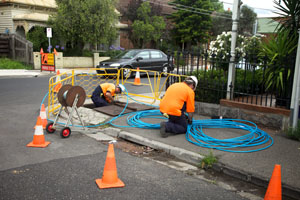Brunswick renters posed NBN challenge

The inner-city Melbourne suburb of Brunswick has gone live on the National Broadband Network (NBN) today, but has been afflicted by a low sign-up rate due to the high number of renters and apartment buildings in the area.

Laying fibre in Brunswick. (Credit: NBN Co)
Of the total 2689 premises covered in the Brunswick roll-out, only 1405, or 52 per cent, opted to have the NBN fibre connected to the home. This represents the lowest sign-up rate for any of the first five mainland release sites for the NBN. As the suburb has a mixed population of younger professional renters and immigrants from Europe, NBN Co has previously blamed difficulty with getting permission from landlords and a language barrier for non-English-speaking residents as the reason behind the low take-up rate.
At a press conference in Melbourne today, NBN Co chairman Harrison Young admitted that part of the difficulty lay with getting permission from the body corporate of apartment buildings to lay the fibre into every apartment unit.
"For a multi-dwelling unit, you have to run wires up the thing and get permission from the body corporate, or, if it is a rental apartment, you have to deal with the owner of the apartment building, so it's sort of an indirect process."
NBN Co's head of product development, Jim Hassell, told ZDNet Australia that the company was still working on the best way to get all apartments covered in the roll-out, and said the company faced three layers of approval before it could go in.
"The body corporate is the starting point to get access. Once you get that, people have to agree to have the fibre come into their individual apartments, because we'll put a network termination device in the apartment," he said. "The third problem is a lot of those buildings ... have a lot of people renting in them, and so you've got to get owner consent and renter [consent]."
A big technical challenge was also posed by older apartments. Communications Minister Stephen Conroy said this morning that the government had been in discussion with apartment owner groups about the best way to overcome the difficulties in installing fibre in the older unit blocks.
"Obviously, if they ultimately say no, this is not something we are forcing people to take ... life will go on," he said.
Conroy said that lower take up in Brunswick was irrelevant, with the $11 billion deal between NBN Co and Telstra to be voted on by shareholders in October, meaning that Telstra would decommission its copper network.
He said that it would also be an economic incentive for homeowners to have the fibre put in, saying that house prices will be higher for those that have fibre instead of copper.
Prime Minister Julia Gillard said that education would be key to bringing people in the suburb on-board.
"This is also the home to a lot of people who migrated to this country and who will need assistance in their original languages to understand the power of the National Broadband Network," she said.
Fourteen trial users have so far connected to the NBN in Brunswick, giving NBN Co a total of 114 trial mainland customers. Conroy said this number was deliberately kept low while testing was conducted, and that more will be brought on when commercial services begin in October.
"It's not open slather — it becomes open slather in October, and we're hoping to, by October, have about 200 people at each site around the country. We didn't want too many more in the first few days; we're building this up slowly."
Conroy hinted that telco contracts may lead to this initial number being lower than people expect.
"As people have made the point, people often have two-year contracts. So you may have it connected already, but you may have six months to go in your Telstra contract, you're not going to break your contract and take up NBN Co," he said. "So it's not like every single human being will suddenly decide they will take the new service from day one."
Lessons
Hassell said the Brunswick trial gave NBN Co a chance to test out some of the issues that the company will face as it rolls out the NBN to urban areas.
"There was some challenges in Brunswick, because your access to roads is all different when you've got very busy built-up areas. The Brunswick route is all underground, using all underground infrastructure, which was already in place," he said.
NBN Co's chief technology officer Gary McLaren told ZDNet Australia that Brunswick taught NBN Co the most efficient method of rolling out fibre in areas with limited duct space.
"We worked closely with Telstra on the build there, and the actual way that we've designed the fibre optic cable, we've got a lot of learnings from that we're now applying in our architecture going forward," he said.
McLaren said that the company was now using ribbon fibre, which was 12 fibres in one. He said this allows NBN Co to splice (join the fibres to a connector or to terminal equipment) all at once, rather than individually.
"With a ribbon, you can actually splice all 12 ribbons with one process with the actual field splicer. So you can get a 12-to-one productivity improvement with splicing," he said.
"It is also a lot more effective in terms of the space you use."